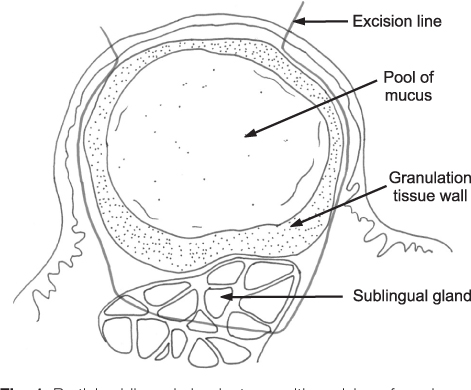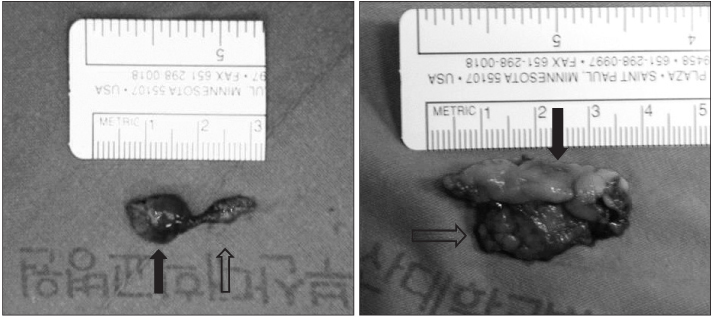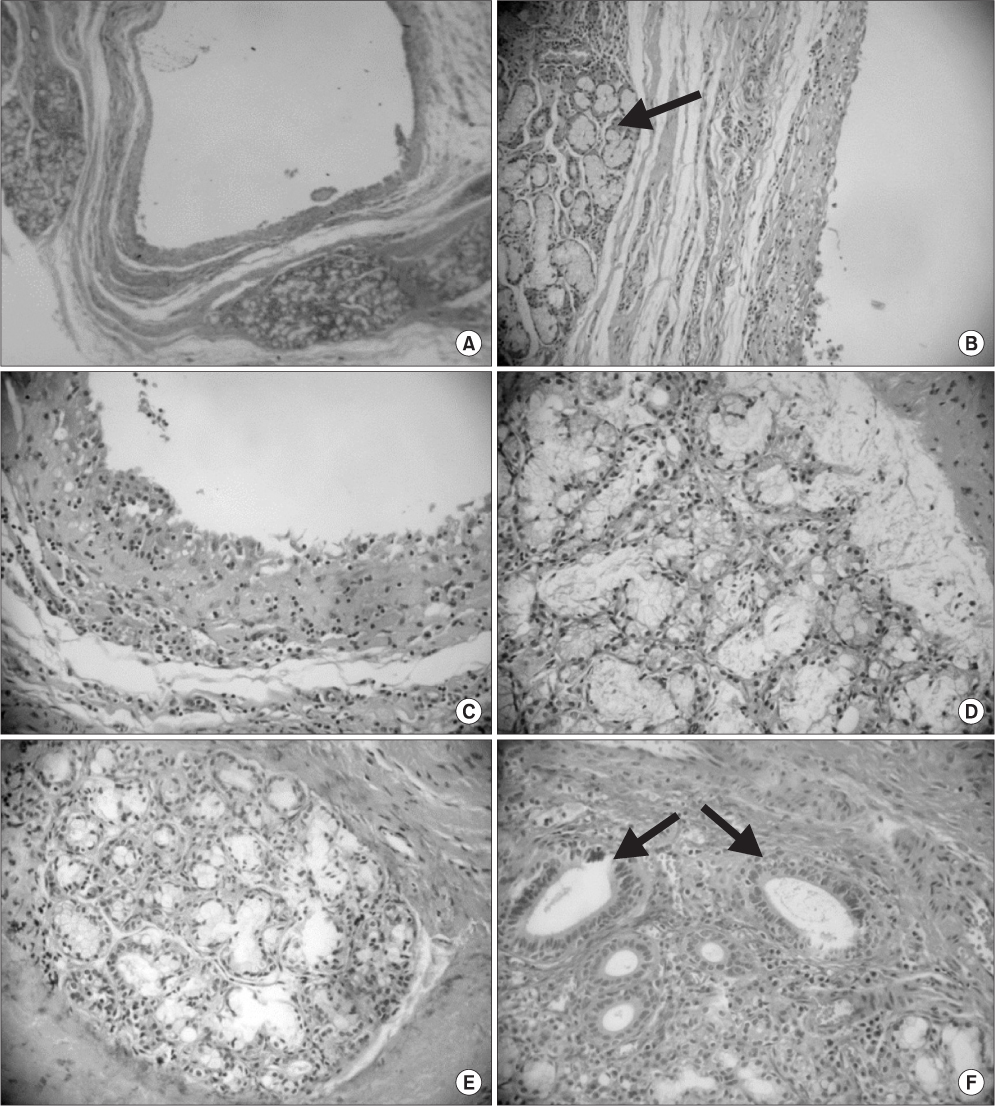J Korean Assoc Oral Maxillofac Surg.
2012 Jun;38(3):160-165. 10.5125/jkaoms.2012.38.3.160.
Partial sublingual glandectomy with ranula excision: a new conservative method for treatment
- Affiliations
-
- 1Department of Oral and Maxillofacial Surgery, School of Dentistry, Pusan National University, Yangsan, Korea. id9753153@gmail.com
- 2Department of Oral and Maxillofacial Pathology, School of Dentistry, Pusan National University, Yangsan, Korea.
- KMID: 2043845
- DOI: http://doi.org/10.5125/jkaoms.2012.38.3.160
Abstract
OBJECTIVES
This study evaluated the clinical results of partial sublingual glandectomy accompanying the excision of ranula as new treatment modality.
MATERIALS AND METHODS
A total of 43 patients who were treated between 1999 and 2007 for oral or plunging ranula were reviewed. All patients were treated surgically by various methods with a total of 55 different procedures performed. Ten cases of partial sublingual glandectomy with excision of the ranula were conducted. All excised specimens were examined. We compared the clinical outcomes resulting from each treatment method.
RESULTS
The recurrence rates for marsupialization, excision of ranula, marsupialization with gauze packing, total excision of sublingual gland and ranula, and partial sublingual glandectomy with excision of ranula were 50%, 25%, 25%, 0% and 10%, respectively. Of the 10 patients treated by partial sublingual glandectomy with ranula excision, only one experienced recurrence (10%), i.e., plunging ranula. None of the ranulas contained an epithelial lining, and the excised portion of the feeding sublingual glands showed degenerative changes.
CONCLUSION
In removal of ranulas, we found that excision of the attached sublingual gland, which removed the feeding portion and degenerative acinar cells, yielded good outcomes. Thus, as a new conservative method for treatment, we recommend partial sublingual glandectomy to accompany excision of the ranula.
Keyword
Figure
Cited by 1 articles
-
Case report of the management of the ranula
Moon-Gi Choi
J Korean Assoc Oral Maxillofac Surg. 2019;45(6):357-363. doi: 10.5125/jkaoms.2019.45.6.357.
Reference
-
1. Baurmash HD. Mucoceles and ranulas. J Oral Maxillofac Surg. 2003. 61:369–378.
Article2. Baurmash HD. A case against sublingual gland removal as primary treatment of ranulas. J Oral Maxillofac Surg. 2007. 65:117–121.
Article3. Kurabayashi T, Ida M, Yasumoto M, Ohbayashi N, Yoshino N, Tetsumura A, et al. MRI of ranulas. Neuroradiology. 2000. 42:917–922.
Article4. Shelley MJ, Yeung KH, Bowley NB, Sneddon KJ. A rare case of an extensive plunging ranula: discussion of imaging, diagnosis, and management. Oral Surg Oral Med Oral Pathol Oral Radiol Endod. 2002. 93:743–746.
Article5. Baurmash HD. Marsupialization for treatment of oral ranula: a second look at the procedure. J Oral Maxillofac Surg. 1992. 50:1274–1279.
Article6. Baurmash HD. Treating oral ranula: another case against blanket removal of the sublingual gland. Br J Oral Maxillofac Surg. 2001. 39:217–220.
Article7. Yoshimura Y, Obara S, Kondoh T, Naitoh S. A comparison of three methods used for treatment of ranula. J Oral Maxillofac Surg. 1995. 53:280–282.
Article8. Crysdale WS, Mendelsohn JD, Conley S. Ranulas--mucoceles of the oral cavity: experience in 26 children. Laryngoscope. 1988. 98:296–298.9. Galloway RH, Gross PD, Thompson SH, Patterson AL. Pathogenesis and treatment of ranula: report of three cases. J Oral Maxillofac Surg. 1989. 47:299–302.
Article10. Morita Y, Sato K, Kawana M, Takahasi S, Ikarashi F. Treatment of ranula--excision of the sublingual gland versus marsupialization. Auris Nasus Larynx. 2003. 30:311–314.
Article11. Catone GA, Merrill RG, Henny FA. Sublingual gland mucus-escape phenomenon--treatment by excision of sublingual gland. J Oral Surg. 1969. 27:774–786.12. Barnes L. Surgical pathology of the head and neck. 1985. 1st ed. New York: Marcel Dekker;1297–1301.13. Marx RE, Stern D. Oral and maxillofacial pathology. 2003. Illinois: Quintessence Publishing;511.14. Zhao YF, Jia Y, Chen XM, Zhang WF. Clinical review of 580 ranulas. Oral Surg Oral Med Oral Pathol Oral Radiol Endod. 2004. 98:281–287.
Article15. Bridger AG, Carter P, Bridger GP. Plunging ranula: literature review and report of three cases. Aust N Z J Surg. 1989. 59:945–948.
Article16. Zhao YF, Jia J, Jia Y. Complications associated with surgical management of ranulas. J Oral Maxillofac Surg. 2005. 63:51–54.
Article17. Quick CA, Lowell SH. Ranula and the sublingual salivary glands. Arch Otolaryngol. 1977. 103:397–400.
Article18. Harrison JD, Garrett JR. An ultrastructural and histochemical study of a naturally occurring salivary mucocele in a cat. J Comp Pathol. 1975. 85:411–416.
Article19. Chidzonga MM, Mahomva L. Ranula: experience with 83 cases in Zimbabwe. J Oral Maxillofac Surg. 2007. 65:79–82.
Article20. Frame JW. Removal of oral soft tissue pathology with the CO2 laser. J Oral Maxillofac Surg. 1985. 43:850–855.
Article21. Mintz S, Barak S, Horowitz I. Carbon dioxide laser excision and vaporization of nonplunging ranulas: a comparison of two treatment protocols. J Oral Maxillofac Surg. 1994. 52:370–372.
Article22. Woo JS, Hwang SJ, Lee HM. Recurrent plunging ranula treated with OK-432. Eur Arch Otorhinolaryngol. 2003. 260:226–228.
Article23. Fukase S, Ohta N, Inamura K, Aoyagi M. Treatment of ranula wth intracystic injection of the streptococcal preparation OK-432. Ann Otol Rhinol Laryngol. 2003. 112:214–220.
Article24. Martis C. Parotid benign tumors: comments on surgical treatment of 263 cases. Int J Oral Surg. 1983. 12:211–220.
Article25. Milstein BB. Regeneration in the submaxillary gland of the rat. Br J Exp Pathol. 1950. 31:664–669.26. Hanks CT, Chaudhry AP. Regeneration of rat submandibular gland following partial extirpation. A light and electron microscopic study. Am J Anat. 1971. 130:195–207.
Article
- Full Text Links
- Actions
-
Cited
- CITED
-
- Close
- Share
- Similar articles
-
- Analysis of Treatment Result According to Operative Methods for Ranula
- Case report of the management of the ranula
- Significance of Sublingual Gland Excision in Surgical Treatment of Ranula
- Sublingual Gland Excision and Sclerotherapy for Plunging Ranula and Management of Recurrence
- A Case of Bilateral Plunging Ranula




